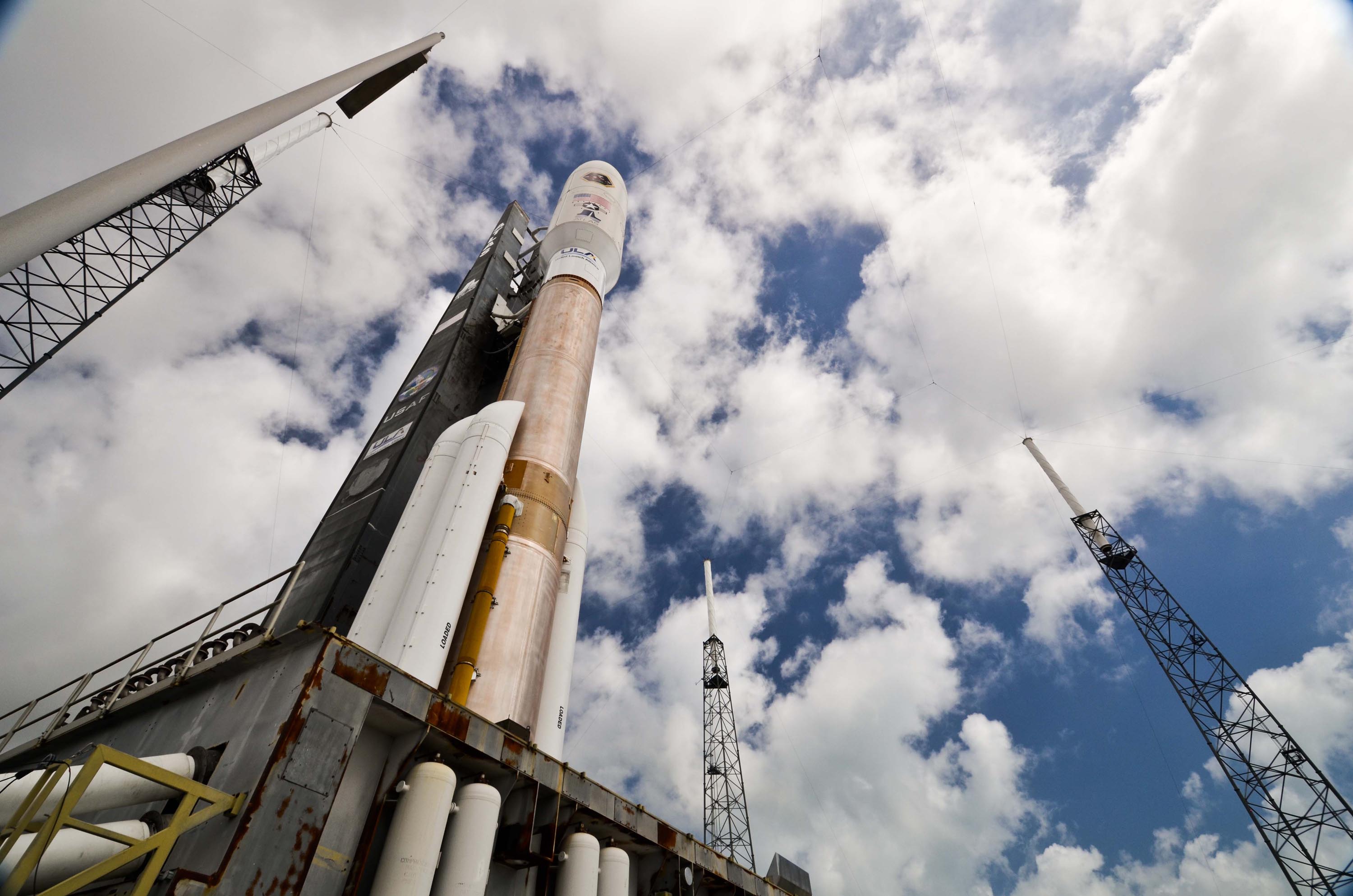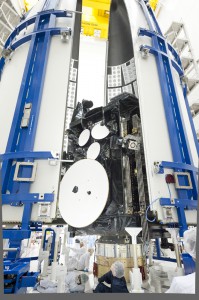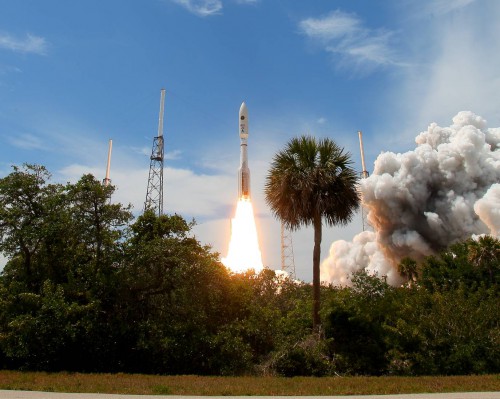
United Launch Alliance (ULA)—the Centennial, Colo.-based launch services organization, which operates the Atlas V and Delta IV vehicles out of Cape Canaveral Air Force Station, Fla., and Vandenberg Air Force Base, Calif.—will launch its 75th mission in the early hours of Wednesday, 18 September. According to ULA, liftoff will occur during a two-hour “window,” which opens at 3:04 a.m. EDT. Weather forecasts currently predict a 60 percent probability of acceptable conditions for an on-time launch. The U.S. Air Force’s third Advanced Extremely High Frequency (AEHF-3) satellite will be boosted into supersynchronous transfer orbit by an Atlas V to become the latest member of a “constellation” of high-powered spacecraft providing fast and secure communications to link civilian leadership with military assets, anywhere in the world.
For only the third time in its operational history, the Atlas V will fly in its “531” configuration, boasting a 5.4-meter (17.7-foot) payload fairing, a trio of strap-on solid-fueled rocket boosters, and a single-engine Centaur upper stage. It has the potential to deliver payloads weighing up to 34,330 pounds into low-Earth orbit and up to 16,480 pounds into geostationary transfer orbit. Stacking of the Atlas at Cape Canaveral Air Force Station began on 2 August, when the central component of the rocket’s first stage was rotated into position on its Mobile Launch Platform. Over the following days, the three Aerojet-built boosters were fixed to their mounting points on the first stage, and on 13 August the Centaur was hoisted atop the stack.

In the meantime, the AEHF-3 satellite arrived in Florida on 10 July from prime contractor Lockheed Martin’s facility in Sunnyvale, Calif. Following the loading of maneuvering propellants and final clean room checks, the 13,600-pound spacecraft was encapsulated within a two-piece (“bisector”) payload fairing and mounted atop the Atlas. “The AEHF team has done excellent work to increase capability of affordability,” said Mark Calassa, Lockheed Martin’s Vice President for Protected Communications Systems. “Our efforts were rewarded in December with a new Air Force vehicles 5 and 6. As we transition to fixed price, we are reducing risk to the customer and lowering satellite cost by over 30 percent with this recent block buy.” Liftoff of AEHF-3 will occur from Space Launch Complex (SLC)-41 at the Cape on Wednesday, during a two-hour “window” which opens at 3:04 a.m. EDT.
Ignition of the first stage’s RD-180 engine will occur at T-2.7 seconds, after which a computer-controlled check of its healthy start-up will be conducted. At T+0.8 seconds, the command will be issued to fire the strap-on solid-fueled boosters, producing a liftoff at T+1.1 seconds and a rapid climb away from SLC-41. Shortly after the Atlas V clears the tower, it will perform a combined roll, pitch, and yaw maneuver to establish itself onto an easterly trajectory to deliver AEHF-3 into orbit. Forty-six seconds into the flight, the vehicle will encounter maximum aerodynamic pressure—known as “Max Q”—on its airframe. According to ULA’s mission brochure, the strap-on boosters will burn out at T+92 seconds, with two of them being jettisoned at T+115 seconds and the third at T+116 seconds.
With the solid boosters gone, the RD-180 will continue to burn hot and hard for a further three minutes, during which time the payload shroud and fairing will be jettisoned. Shutdown of the first stage engine will occur at T+257 seconds, followed by the separation of the Centaur upper stage and attached AEHF-3 payload. The Centaur will ignite at T+279 seconds and burn for a little less than 10 minutes, cutting off about 14 minutes after launch. The combo will then coast for eight minutes, ahead of a second, five-minute-long Centaur burn. This will be followed by the upper stage readjusting its attitude for the separation of AEHF-3 and a passive thermal control roll maneuver. AEHF-3 is scheduled to separate from the Centaur about 51 minutes after launch.
Built by Lockheed Martin, AEHF system replaces the outdated Milstar network. Its first mission, AEHF-1, was launched in August 2010, followed by AEHF-2 in May 2012. After the launch of AEHF-3, three more satellites in the network will fly. The satellites operate at extreme high frequencies (44 GHz uplink) and super-high frequencies (20 GHz downlink) and can relay communications directly without passing through ground stations. Their phased array antennas help to eliminate possible sources of radio jamming, and each AEHF spacecraft can support data rates as high as 8.192 Mbits/sec. By the time the sixth and final member of the constellation reaches operational service, AEHF will provide full surface coverage between 65 degrees North and 65 degrees South latitude.

Last week, prime contractor Lockheed Martin reported that The Netherlands has become the second international partner to communicate through the AEHF network, which currently boasts two satellites in orbit. “During July,” the contractor explained, “for the first time three nations used the system simultaneously as The Netherlands connected to U.S., Canadian and domestic terminals.” The AEHF constellation’s ability to securely connect the United States and its allies “is vital to current and future operations,” according to Mark Calassa, Lockheed Martin’s Vice President of Protected Communications Systems. “We are hard at work delivering this global capability. Our fixed-price production builds are on schedule, we will launch a third satellite next week, and those users testing the system are extremely satisfied with this leap forward in capability.”
The U.S.-Canada-Netherlands team utilized both the AEHF-1 and AEHF-2 satellites, whilst conducting test calls between international terminals. Dutch forces exchanged voice and data communications with the United States and Canada through AEHF-2, crosslinking with AEHF-1 and downlinking to a U.S. Navy terminal in San Diego, Calif., and a Canadian terminal at Shirley’s Bay, Ontario. This marked the first occasion on which The Netherlands performed a local AEHF call from ship to shore.
ULA currently operates three vehicles—the Atlas V, the Delta IV, and the Delta II—and has established for itself an impressive success record. Despite a Centaur glitch in June 2007, which produced a lower than intended thrust for its classified payload, the Atlas V has performed virtually without a blemish. The Delta IV, too, has only once seriously underperformed: On the maiden voyage of its Heavy configuration, back in December 2004, the vehicle suffered a premature engine shutdown during ascent. More recently, it also endured and recovered well during a problematic launch last October. As for the Delta II, it is one of the most reliable U.S. launch vehicles currently in active operational service. Although it has not flown since October 2011, it is slated to launch NASA’s Orbiting Carbon Observatory (OCO)-2 in July 2014.
Aboard the Atlas V, key missions have included the latest Landsat, the Lunar Reconnaissance Orbiter (LRO) and Lunar Crater Observation and Sensing Satellite (LCROSS), and NASA’s Juno spacecraft to Jupiter. Meanwhile, the Delta IV has boosted large missile warning satellites, reconnaissance satellites, weather satellites, and military communications satellites—most recently, last month’s launch of the sixth Wideband Global Satcom (WGS-6)—which have ensured that the United States’ military assets retain the high ground in space. Additionally, Delta II vehicles have lofted NASA’s Phoenix mission to Mars, the Dawn asteroid exploration spacecraft, and the Kepler extrasolar planet-hunter.
Want to keep up-to-date with all things space? Be sure to “Like” AmericaSpace on Facebook and follow us on Twitter: @AmericaSpace
Missions » AEHF » AEHF-3 »



One Comment
One Ping
Pingback:Wired4Space